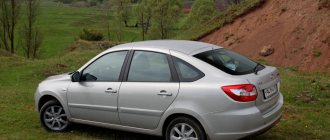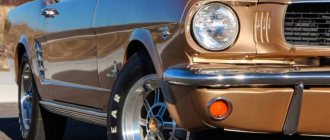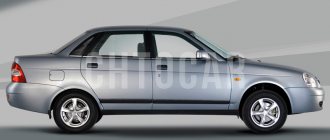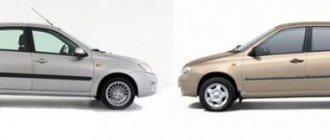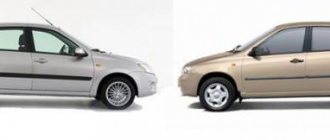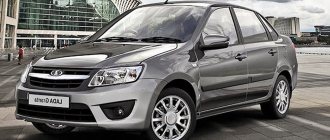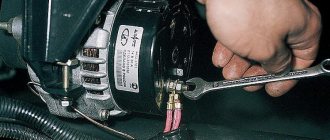Multimedia system with 7-inch touchscreen, navigation and Bluetooth support. Light and rain sensors, heated windshield, electric drives for all windows, climate control and even cruise control... Active safety is guarded by ABS, EBD (brake force distribution system) and ESC (exchange rate stability system). Passive airbags are provided by front airbags and three head restraints in the rear seat. Of course, there are such simple options as central locking, heated front seats and Isofix mounts in the rear. And yes, all this is a modest liftback, albeit in the top-end “Lux/Navigation” version. Until recently, such a car cost 571,200 rubles, but later the price rose to 586,200 rubles. Agree, it’s damn tempting to get such a set of options at such a still attractive price. But is all this necessary in Grant?
Looks great. In my opinion, the five-door is much more harmonious than the sedan with its heavy rear lights. And if you look at the Lada from afar on a foggy day, the Granta is almost a Bavarian three-ruble GT. Fifteen-inch alloy wheels, turn signal repeaters in the side mirrors - modern and fashionable. In general, the liftback looks worth the money and even more expensive. Exactly until you pull the tight door handle and find yourself in the driver's seat.
The most annoying thing is that Grant's problems are by no means fundamental. Overall, the ergonomics and seating geometry are not so bad here. It’s just a pity that the driver’s seat is set a little high and there’s no way to lower it any lower. And the steering wheel height adjustment is limited to thirty-five millimeters (in Logan the range is twice as large). However, these nuances cannot be clearly attributed to disadvantages. But other interior details are possible. And there are a billion of these little things.
The Itelma multimedia system does not raise any unnecessary questions at first acquaintance: it has an adequate menu structure, tolerable performance and a normal touchscreen sensor. You just have to turn off the multimedia manually every time - it doesn’t “stall” along with the machine. Moreover, I don’t know why AVTOVAZ needed this head unit in the first place - after all, the Lada-Renault-Nissan alliance has access to the LG multimedia complex (the kind they install on XRAY, Logan,) which is superior to Itelma in both graphics and performance. Is Korean multimedia really more expensive?
The USB port located on the inside of the glove compartment leaves an unpleasant aftertaste. The uneven force on the “wings” of the climate control unit and the fittings from even earlier VAZ cars (admire the handbrake handle) are also frustrating. The abundance of silver was added: it is present on the panel elements and the shagreen plastic of the door handles. According to someone's good intentions, such a decision should have given the salon more solidity, but in fact it had the opposite effect. The interior of the Granta lags behind the exterior and every second reminds you that you are sitting in a very budget car.
But the back row pleased me. Despite the sloping roof, there is no less headroom here than in the Ravon Nexia sedan (aka the previous generation Chevrolet Aveo). Thus, even with a height of 185–190 cm, you can fit quite comfortably. Riding in the back won't cause any discomfort either, although Grant's shoulders feel a little tight. The same Renault Logan is noticeably more spacious in this sense. The Granta liftback partly makes up for it due to its spaciousness. In pure volume, it is inferior to Loganov’s 4 liters (396 liters versus 400 liters - according to our measurements), but in terms of convenience it is many times superior. An assembled bicycle for an adult or fairly large household appliances can easily fit here.
To be honest, there is no desire to talk about the shortcomings and features of the VAZ robot for the hundredth time. And it doesn’t make much sense either - you are either well aware of the hopelessness of the AMT, or you are absolutely sure that the box is a wonderful miracle, and journalists are corrupt lazy people and simply have not learned how to handle it. In general, highlight the necessary ones and let's move on. Fortunately, Granta gives enough other reasons to talk about himself.
Under the hood of our car is a 1.6-liter sixteen-valve engine with a power of 106 hp. I must say, the engine is good. If it weren't for wasting his talents, our liftback could easily be called one of the most dynamic cars in the class. Not in seconds, but in sensations. With all this, the Granta is very economical: actual fuel consumption was 7 liters of fuel on the highway and 8.5 l/100 km in the city. Part of the reason is that the car is quite light. Our measured curb weight is only 1097 kg. The main competitors are 50–100 kg heavier.
The energy intensity of Lada suspensions is beyond praise. Grant copes with broken asphalt and primers under the wheels no worse than Logan, whose suspension sings praises with amazing frequency. The only pity is that in terms of handling, the “Russian” is not up to par with its main competitors. There is much less feedback on the Granta's steering wheel than I would like. And even at decent speeds, the steering wheel is annoying with a frightening weightlessness. There are no questions about the effectiveness of the brakes, but not everyone will like the nonlinear force on the pedal.
Is this Grant worth the money? Everyone will answer this question for themselves. If a long list of options warms your soul, then why not? Yes - many of them do not work perfectly, but in general such a car has a right to exist. If you are interested in my opinion, I will never buy such a car for my family - fortunately, there are more than enough options even in this budget. For the same money you can buy a slightly more modest Grant (or Datsun) with a classic Jatco automatic transmission. Or you can refuse the automatic transmission, pay an additional 50 thousand rubles and buy something from the bunch - Hyundai Solaris - Kia Rio. With a manual transmission, a pair of airbags, simple air conditioning and front electric windows. This whole trio drives much more thoroughly, and each of these cars is made with great respect for its future owners. For me personally, these qualities are more important than the navigation system and cruise control. And for you?
Grant became four: sedan, liftback, hatchback and station wagon. VAZ has finally put things in order in the configurations, and now 14 versions are offered for each of the cars. They are the same for all body types. So, having chosen the optimal set of options, you won’t have to be upset that the Grant you need is not sold with it. Full parity.
The most affordable is a sedan. It costs from 419,900 to 608,800 rubles. The liftback and hatchback are 17 thousand rubles more expensive, the surcharge for a station wagon is 27 thousand. Considering the class of the car, the money is not that small. For example, for 25 thousand you can get a robotic gearbox instead of a mechanical one or take the next level of equipment. Therefore, when economy comes first, the sedan is in favor.
Note that the VDA technique involves measuring volume along the window sill line. Neither the manufacturer nor we measure to the ceiling (no measuring cubes are enough). But we can assume that the leaders in terms of full load will be the liftback and station wagon. The sedan has an obvious disadvantage due to its limited horizontal trunk lid, and we write off the hatchback, again due to the short rear overhang.
Let's not forget about design, although, of course, it is secondary for many. But, in my opinion, the liftback is the most harmonious and beautiful Grant. In addition, after restyling, it was refined with a bumper cover in body color, adding originality.
Lada Sedan, after its “loud” entry into the market back in 2011 and an equally noisy PR campaign, managed to win love throughout Russia. From approximately 2011 to 2013, every second passenger car purchased was a Sedan from the Lada Granta. Orders grew... And it was their growing number that forced AvtoVAZ to optimize production and introduce some new items into the updated model.
In 2014, Lada Granta returned to the market with an updated Liftback body. The updates didn’t end there: the design and some structural elements also underwent changes. When something new comes out, people generally buy it “new”, but is the “new” always better? Or is this “new” actually a modified “old”?
Created in 2011, so distant for us, the Lada Sedan was distinguished by the variety of choices of its configurations, suitable for different requirements, from the appearance of the interior to the “filling”.
It is clear that from “Standard” to “Luxury” there are completely different price categories, but still there is a lot in common between them, namely: cheap design (one look at the side mirrors and low-quality plastic on the dashboard can tell a lot about the integrity of the designers AvtoVAZ), but at the same time, the interior was very spacious (a person 1.95 m tall can comfortably sit in a car), and the trunk was very, very pleasing with its volume - as much as 520 liters, and this despite the fact that for this you do not need to move anything away, remove or etc.
Considering the relative cheapness of the car (the average price of a new Lada is 420 thousand rubles), one can understand that the maintenance of the car will be appropriate. Starting in 2012, a modification was added: a four-speed automatic transmission from the Japanese manufacturer Jatco. But the surprises didn’t end there; however, they started getting unpleasant: tens of thousands of cars were recalled in 2013 due to problems with airbags.
LADA Granta Liftback
There’s a wagon and a small cart of all sorts of nice goodies:
- Updated design that looks more harmonious and neat than the Sedan.
- The side mirrors look much better than the Sedan's.
- Now, if you leave the key in the ignition, a beep will sound, which will reduce the likelihood of the car being stolen from a forgetful owner.
- The trunk comes with a standard capacity of 440 liters
, but if you fold the rear seats, the trunk will expand to 760 liters, but the convenience of such a transforming trunk will need to be assessed by the buyer himself. - A stiffer suspension means less shaking, but worse handling.
- The ground clearance was “raised” by 15 millimeters
and improved cross-country ability. - The dynamics of the Liftback is 12.3 seconds
. - The Standard version does not have a rear wiper. AvtoVAZ designers claim that the rear window is blown by air currents and therefore there will be no dirt there during rain. And at the same time, the “Norma” and “Lux” versions have a rear windshield wiper. For what? I'm afraid we will never know the answer to this question...
- The “Lux” version has much better, more powerful anti-roll bars than other versions.
- The springs for this version were also tightened, and the shock absorbers were filled with gas, but at the same time, mainly due to the denser suspension on the Liftback, the ride smoothness decreased.
- The average retail price of Liftback is from 314,000 rubles to 477,500 rubles
.
Common features between Sedan and Liftback
To be honest, despite some upgrades and external differences in design, the internal components have remained mostly the same and here are some proofs of this:
- The Liftback's taillights, of course, have become narrower, but at the same time they remain the same on the inside.
- The engine capacity of both models is 1596 cc.
cm . - Gas tank volume is 50 liters
. - The difference between the maximum speeds of the Sedan and Liftback is only 3 km/h: the Sedan has a maximum speed of 182 km/h
, and the Liftback
179 km/h
.
Which is better: “new” or “old”? Who is it suitable for?
In terms of characteristics, the changes in the Liftback are not as significant as the changes and increases in price compared to its “ancestor”. But if you look purely at them, then this model is suitable for people who care about their position in society or for those people who need a spacious trunk. However, if you look at convenience, then Lada
The sedan is suitable for families with children - in this car it will be easy to keep track of everyone, and there will be a place for everyone. In case of any breakdown, it will be much easier to find spare parts for this particular model. Therefore, when choosing a car from those presented, you need to look at what exactly is expected from the vehicle: appearance or price.
In recent years, cars have begun to actively appear on the domestic market, which cannot always be confidently classified. Beginners are rarely able to analyze current technology, so they often have the question of how a liftback differs from a hatchback and which option is better to choose.
Hatchback in the city
What is the difference between a liftback and a hatchback, what is the difference? We begin to answer the question by considering the first body type, namely the hatchback. Today in a large city you need to have a car that provides maximum comfort and at the same time has excellent maneuverability. It can be noted that the last century was 100% the reign of sedans on the roads, but with today's boom in cars, they are no longer so welcome in urban environments.
For example, you can often hear that due to the length of the sedan, it is not always convenient to maneuver from lane to lane, and parking is not worth explaining.
How to solve the problem associated with the length of the car? Automakers found a solution by radically changing the car body, namely:
- The trunk compartment was connected to the passenger compartment;
- the rear of the car was greatly shortened;
- They placed the engine transversely and made it front-wheel drive.
Such a radical change in the sedan body led to the birth of a new body – the hatchback.
It can be translated from English as: “back hatch.” The combination of trunk and interior is bad only in one case
: When a car is involved in an accident, the contents of the luggage compartment are thrown into the cabin.
Features of the liftback
Liftbacks are most popular in the American market
A liftback is a passenger car that is almost identical in design to a sedan and combines elements of both a hatchback and a sedan. In this model, the rear overhang is not made in a vertical form, but neatly flows into a protruding trunk.
Liftbacks often implement several methods to open the rear door - either entirely or exclusively with a protruding element.
The word liftback is derived from the English. lift - to raise, back - back and means “rising back”.
Defining Features
The main feature that helps determine a liftback is the length of the rear overhang, which does not depend on the number of visual volumes.
For example, this body has the same length as the sedan, while the hatchback is much shorter. The rear window of the liftback is less vertical and is a continuation of the trunk lid all the way to the roof of the car. The term liftback was coined by automakers in order to highlight this body and show its tangible differences from the sedan (much more practical) and from. It does not have a specific classification, so it can also refer to types such as sedan or combi.
Most liftbacks are two-volume bodies. However, you can also find three-volume ones. Names such as liftback-notchback also apply to this type.
Distinctive features of the hatchback
In the event of an accident, the contents of the trunk may “fly” into the cabin and injure passengers sitting in the rear seats.
The hatchback is characterized by the following features:
- the luggage section is combined with the salon;
- the rear overhang has been significantly shortened;
- The main standard is a drive system with a transversely mounted motor.
New cars began to be called hatchbacks, since they are equipped with a rather unusual design with a rear door through which access to the luggage compartment appears. Today, hatchbacks are produced in three- and five-door configurations.
The word hatchback is derived from the English. hatch - hatch and back - behind, which literally means “rear hatch”.
What is better to choose
For domestic consumers, both hatchbacks and liftbacks are of interest as cars for urban conditions, which are much more convenient than a sedan due to their dimensions and design solutions
The two body types described above can be safely classified as passenger cars. If you compare them with each other, the following differences will become noticeable:
- The liftback is almost identical to the sedan, since it also has an extremely long rear overhang.
- The hatchback is equipped with a single-volume body - the trunk and interior seem to be an ode to the whole component.
- The liftback is produced in different versions of the rear door opening.
- Liftbacks can be either two-volume or three-volume.
Hatchbacks are much better suited for novice drivers than sedans, since they are easier to get used to the dimensions.
Upon visual comparison of the above models, it will become clear that the rear element of the hatchback is without protrusions and is almost perpendicular to the ground. But not everyone likes the appearance of a hatchback and its respectable size, which is why liftbacks are in particular demand.
Thus, these versions are characterized by many differences, so they are selected by users depending on their preferences. Those who are burdened with a family and need a small car for the city pay attention to the hatchback. If you want to buy a large car, but a sedan is not suitable due to the size of the luggage compartment, then people turn their attention to liftbacks.
During its presence on the markets (since 2011), it became the most popular in Russia, replacing outdated “tags”. For the first two years, every 15th passenger car sold in Russia was of this particular model. A large number of orders forced AvtoVAZ to optimize production. In 2014, a new model from Lada Granta went on official sale - with a liftback body. The new product is distinguished by its design and improved structural elements. With its release, car enthusiasts who want to purchase this model are thinking about the question: What is better than the Granta sedan or the Granta liftback? Let's look at the differences between these versions in order to decide which one will be more useful for you and what benefits it will give you.
What is the difference between a liftback and a hatchback?
The liftback can be called a transitional link between a standard sedan and a hatchback. Here are the main differences between these bodies.
| Liftback | Hatchback | |
| Roof | sloping | sloping or flatter |
| Trunk | protruding, separated from the passenger compartment by a partition, like sedans | combined with the interior, as in station wagons |
| Trunk lid | separate cover or full door mounted on the roof | upward opening door |
| Rear overhang | smooth slope with luggage compartment overhang | shortened, ends smoothly at the rear bumper (usually vertical, as in station wagons) |
| Body shape | two-volume (resembles a hatchback) and three-volume (resembles a sedan) | only two-volume |
Thanks to design solutions that increase the practicality of the car, such models are very popular among many car enthusiasts.
on the left is a liftback; hatchback on the right
Car companies often use this type of body to refresh their lineup without changing the technical parameters of the vehicle. Such a marketing ploy sometimes saves the series during a decline in customer interest.
Among the advantages of the liftback, it is worth noting the safety of passengers when the trunk is loaded at maximum. Hatchbacks need to install an additional barrier in the form of a mesh so that luggage does not fly into the cabin during an accident.
In terms of trunk volume, the liftback is clearly inferior to the hatchback, because in many models the space above the trunk shelf is often left unoccupied.
Many motorists consider liftbacks to be the best body option. Thanks to the presence of a rear door, it is easier (than in a sedan) to place large luggage. However, in the post-Soviet space, such modifications are often equated to hatchbacks.
